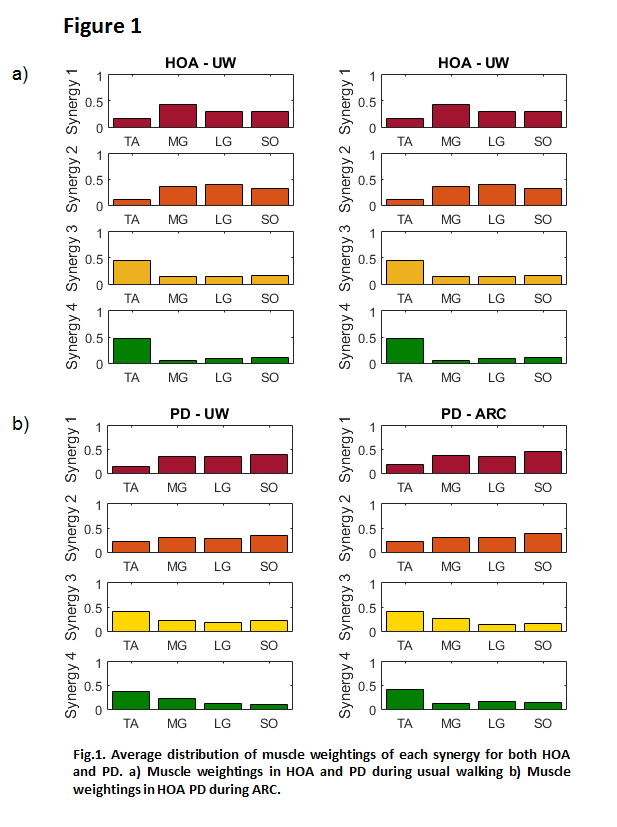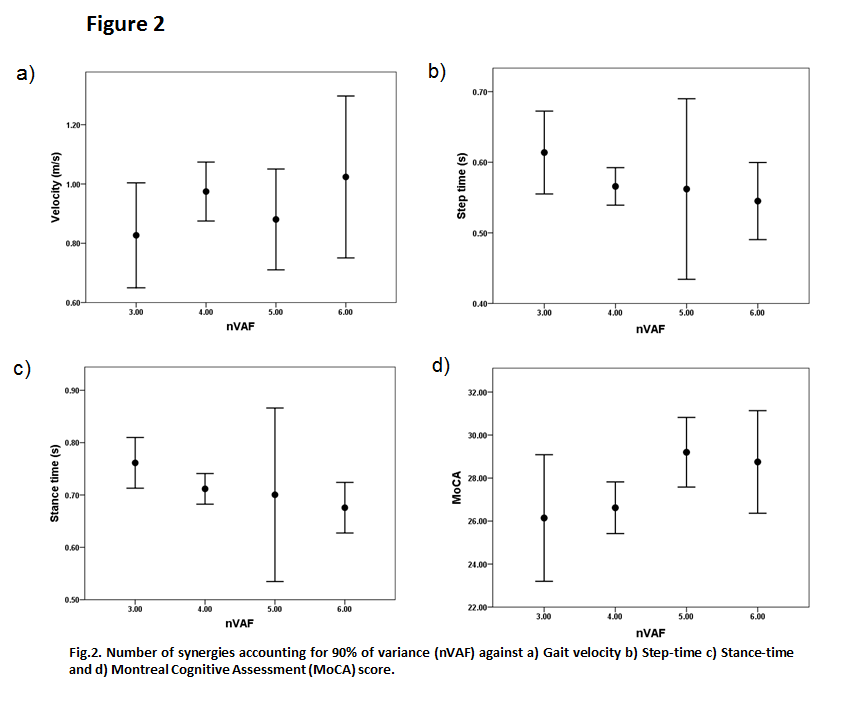Session Information
Date: Sunday, October 7, 2018
Session Title: Other
Session Time: 1:45pm-3:15pm
Location: Hall 3FG
Objective: (1) Evaluate changes in gait motor activity patterns induced by auditory rhythmic cueing in people with PD. (2) Investigate change in gait parameters.
Background: PD is characterised by motor dysfunction such as gait impairment, increasing falls and disability. ARC may normalise stepping through auditory feedback by changing patterns of coordinated muscle activity, called muscle synergies [1]. These synergies may form the basic units of the motor system required to execute behaviour. Investigation of lower-limb muscle synergies during walking with ARC may reveal underlying mechanisms of ARC on motor control strategies in people with PD.
Methods: We recruited 38 participants; 13 healthy older adults (78 ± 7 years, 47% female) and 25 with PD (70 ± 5 years, 37% female). Global cognitive function was assessed with the Montreal Cognitive Assessment (MoCA). Surface electrodes (Cometa, Bareggio (MI) Italy) measured lower limb muscle activity bilaterally from ankle dorsiflexors (tibialis anterior) and plantarflexors (medial gastrocnemius, lateral gastrocnemius and soleus). Participants walked overground for 30 seconds in alternating bouts of usual walking (UW) and ARC walking. Muscle synergies were determined using non-negative matrix factorisation (NNMF) and the number calculated accounting for 90% of overall variance (nVAF) [2]. Gait parameters (velocity, stance-time, step-time) were determined from trunk accelerometery recordings and correlated using Spearman rank with nVAF.
Results: NNMF extracted 4 synergies per task [figure 1]. No change (p<0.5) in nVAF between UW and ARC in HOA was found. Following ARC, nVAF increased in the PD group from 88% to 91.8%. Additionally, in the PD group, positive correlation was found between nVAF and velocity during ARC (r=0.43, p=0.048) and negative correlations between nVAF and both stance-time (r=-0.53, p=0.011) and step-time (r=-0.637, p=0.001) [figure 2]. The MoCA score was positively related to nVAF during ARC (r=0.412, p=0.045).
Conclusions: In the PD group, ARC walking increased nVAF compared to UW. Increased nVAF suggests greater motor control complexity and is associated with improved gait performance during ARC walking. Greater nVAF is also related to higher cognitive function. Patients with PD who may benefit most from ARC applied during walking by changing motor control strategies are those with better cognitive function.
References: 1.Lacquaniti et al. (2012). J Physiol 590, 10. 2.Chvatal& Ting.(2013).Front Comput Neurosci,7,48.
To cite this abstract in AMA style:
A. Islam, C. Chen, l. Alcock, K. Nazarpour, L. Rochester, A. Pantall. Auditory rhythmic cueing changes motor control during walking in Parkinson’s disease [abstract]. Mov Disord. 2018; 33 (suppl 2). https://www.mdsabstracts.org/abstract/auditory-rhythmic-cueing-changes-motor-control-during-walking-in-parkinsons-disease/. Accessed December 22, 2025.« Back to 2018 International Congress
MDS Abstracts - https://www.mdsabstracts.org/abstract/auditory-rhythmic-cueing-changes-motor-control-during-walking-in-parkinsons-disease/


